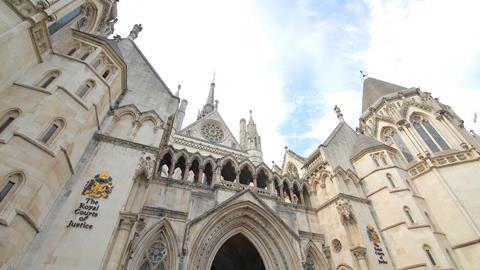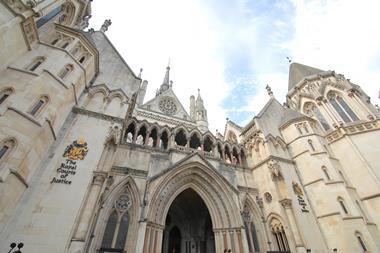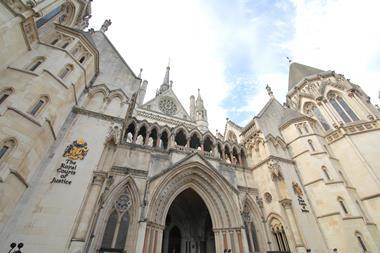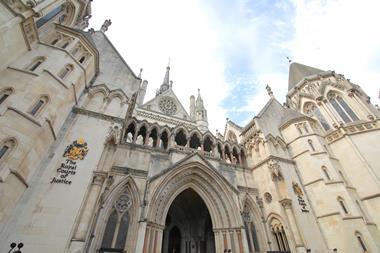A test case brought by the FCA against eight insurers could have significant consequences for insurers, brokers and policyholders. We report on the latest from the High Court…
16.40: That’s it for day three. Tomorrow morning will kick off with th case from the Hiscox Action Group
16.34: Edey says that 2,000 square miles is ‘no ones idea of close spacial proximity’, so RSA’s policy fails its own test, which ’cannot possibly be right’
16.27: Edey says it would be reasonable to expect that any instance of Covid-19 in the UK would have an impact on every business in the country
16.18: QBE argue that cover only applies if the insured can prove that lockdown restrcitions were introduced because of the cases of Covid-19 that occured in the relevant area and not elsewhere, but Edey says that in the context of notifiable diseases ‘that makes no sense’
16.15: Edey says that insurers should not require satisfaction of the proximate cause test, but something looser than that.
16.11: Edey says that the burden of proof (that businesses would have lost income even without the government’s orders for them to close) should lay with the insurer
16.08: Edey says that if you omit the interruption interferrence from the description of the insured peril, when you get to the counter factual, you are ‘almost bound to go wrong’, as Edey argues QBE goes wrong
16.02: Edey says cover should extend to when a notifible disease extends to become a pandemic. The purpose of the area requirement in QBE’s wordings precludes cover if there is not the relevant notifible disease within the relevant area - Edey calls this a ‘postcode lottery’.
16.00: Edey will start talking on QBE and RSA, discussing the insured peril and causation as well as the specific disease cover. Edey says that insurers are focusing on the word ‘pandemic’ as being hugely different to a ‘notifible disease’. However Edey says it is actually common ground that a notifible disease can become a pandemic.
15.59: Mulcahy closes her submission on Argenta and closes the submissions on the insurers. She hands over to Philip Edey QC to speak on behalf of the interveners.
15.57: Argenta’s exclusion doesn’t seem to exclude anything by saying that the premises has to be affected by an occurance of Covid-19 within the stated 25 mile radius. This is a common clause, but not an exclusion.
15.54: Argenta separates local and national occurances. The broader pandemic caused local incidents within 25 miles. The occurances within this radius were part of the broader pandemic, however, argues Mulcahy. Argenta said the local occurance is not in the causal chain at all, however Mulcahy disagrees.
15.51: Argenta said that the Leicester response would trigger cover, relating to the localised lockdown - this is covered, but not a broader lockdown. Losses by national restrictions are not covered, but a localised lockdown pertaining to Covid-19 within 25 miles is covered. Mulcahy asks what would happen if a region was locked down? Argenta’s response is not realistic here in separating the types of lockdown. The UK is made up of regions.
15.50: Cover will respond if there is a case of the disease within 25 miles, but not if this occurs after a public authority response, said Mulcahy, despite these factors going hand in hand she added. Argenta separate this out however.
15.46: The main issue is causation said Mulcahy. Argenta said the disease can go beyond the 25 miles, but the interruption was not the result of the disease within 25 miles, but the result of the broader pandemic and the corresponding government action, which does not trigger cover. Argenta said it will not pay any interuption claims from 16 March - implies that announcement on this date led to interruption to holiday locations. On this date, said shouldn’t travel for non-essential journeys, such as holidays. Interruption is therefore caused by government speech, not the disease. Government intervention stops cover.
15.44: Argenta’s approach is slightly different, said Mulcahy. Accepts businesses were interurpted from 21 March, and that interruptions to holiday accommodation was from 24 March, in line with goverment announcements to close. The 26 March regulations also caused interruption, as long as bookings did not fall within exceptions, such as attending a funeral. This stance accepts that there was still interruption, even if some hotel rooms, etc were being used - interruption to part of a business is enough - Mulcahy agrees.
15.42: Argenta’s wordings cover any notifible disease within a 25-mile radius of the property, similar to QBE’s wordings, said Mulcahy. An occurance includes anyone within that 25-mile radius contracting the disease or displaying symptoms.
15.40: Mulcahy kicks off looking at Argenta wordings, focusing on guest houses and restaurants.
15.30: The court breaks. Next up - QC Mulcahy will look at Argenta
15.22: £10,000 (the policy limit) ’is actually quite a lot of money’ for churches and nurseries, Edelman points out
15.10: Ecclesiastical makes the concession that other insurers don’t that access by the customers (congregation and visitors) was restricted
15.04: Ecclesiastical doesn’t accept that anything before the 23rd March was a ‘hindrance’ to access (to churches)
15.01: ’Put your faith is (unless you make a claim under the current circumstances)’, Edelman mocks
15.00: Next up - Ecclesiastical’s wordings for its ’Parish Plus’ policy
14.56: Insurers’ central argument is that ’nobody pays, even though the disease is everywhere, because they can always point to [Covid-19] being everywhere else as well’, says Edelman
14.50: Amlin says that its use of ‘following’ and ‘resulting from’ are interchangeable in its 97-page policy. Edelman argues that it has ‘following’ was used 75 times and ‘resulting from’ only once
14.40: Amlin denies that pubs, bars, restaurants were subject to a denial of access clause (which would have triggered the policy), because they could still run businesses from those premises (i.e, takeaway), says Edelman
14.35: The disadvantage that the insurers have is that their defences often contradict each other’s position. Will this is make it more difficult for them to win the case?
14.33: Amlin concedes that the government is a recognised public authority, which contradicts Zurich’ position that it is not
14.29: FCA QC Edelman is back on, he’s tackling Amlin’s policy and legal submission (corrected)
14.28: Meanwhile, you can also read Katie Scott’s analysis on the quantum question facing insurers after this case is put to bed. Read it here
14.23: Content director Saxon East has written an opinion piece on what this case is going to mean for insurers’ reputations. Read it here
14.18: Debate on the meaning of ‘following’ in a policy wording sense, both Zurich and Hiscox policies. Is it a strong causal connection? Is it not, Mulcahy argues
14.04: No prevention of access to premises at the end of March, Zurich argues. FCA QC Mulcahy says this is a misreading of the regulations
14.02: The point of debate now is ‘action’, and what it means
13.00: The court is now at recess for lunch. We’ll pick up coverage again at 2
13.00 Zurich pleaded that action does include ’advice’ or guidance, Mulcahy said this is the insurer’s position. She added that ”action” is broader than what is stated.
12.56 Mulcahy says in Zurich’s type one policy that wording is drafted with property in mind. She says it is similar to MS Amlin’s “denial of access clause” which will be looked at after break. Zurich is the only insurer to argue that the government falls within their wording.
12.54 And now on to Zurich. Mulcahy QC says that Zurich is ”something of an extremist compared to other insurers”. It has two types of policies with materially the same wordings, between wordings all categories covered. Type one-BI is included.
12:52 RSA’s counter factuals that you only remove the regulations that are applicable to premises but keep the regulations that are national. Edelman says “you cannot cherry pick like that”
12.49 Referring to page 29 of RSA’s policy for restaurants, the fact that the restaurant is closed but can open as a takeaway although cannot open its dining area means it does not cease to be closed
12.46 Enforced closure - RSA accepts that businesses that are forced to close in part or fully including orders and legislation are covered by the [insured location/business interruption]clause.
12.43 Definition of “vicinity”- an area surrounding or adjacent to events occuring that has an impact on insured or their business. Edelman says that vicinity is a flexible concept, the world could be a vicnity.
12.38 For all these policies insurers must know that they are ”at risk” at providing indemnity for new emerging diseases that become notifiable says Edelman. He gave Ebola and Sars as an example.
12.36 RSA draws a distinction between closure and social distancing measures - the insurer accepts closure measures prevent use but deny that it prevents access, Edelman says.
12.33 RSA accepts that Covid-19 is a public health emergency Edelman said. But the clause does not say that the emergency has to be in the vicinity just that it could likely endanger life, he said this was the case globally and is satisfied.
12.31 RSA acknowledges that advice from government can be ”coercive in effect”- Edelman says this is an important point. It shows a recognition that gov and authorities sometimes act in advisable way that is coercive although not legally coercive.
12.28 On the subject of exclusions Edelman he questioned the page 36 exclusion (b) prevention of access. He pointed out that you cannot have indemnity after access.
12.21: RSA’s policy has the same prevention of access cover, although there is no difference in the cover clause, there is a difference in the exclusion says Edelman. He pointed out what he called an “obvious error” in the clause with the sub limit, although this might not be obvious to the policyholder
12.17 Epidemic and disease go together, it’s [Covid-19] a notifiable disease says Edelman. If you look at the clause, it is not excluded.
11.48: For RSA’s policy covering holiday cottages, the case hinges on whether or not Boris Johnson’s statement telling people to stay at home and not go on holiday places a restriction on holidaymakers or the cottage itself. The FCA argues that places a restriction on the premises and so cover should apply, whereas RSA is arguing that the restrictions are placed on individuals so cover should not be triggered
11.43: And now we turn to RSA, which Edelman QC says has a lot of policy variations to cover, but is not necessarily too difficult to handle
11.11: Edelman QC argues that regardless of explicit knowledge of an instance of the disease, cover should apply, because government action in response to the pandemic displays implicit knowledge of an instance of the disease occurring
11.07: And now we are back to Edelman QC for the FCA to talk about QBE’s policies
11.00: ‘Partial prevention of access is prevention of access’, says Mulcahy QC and that cover should still be in place
10.51: Mulcahy QC argues that the court should instead look at the ‘core business’ of the insured
10.48: Mulcahy QC says that Arch accepts that ordering to cease business amounts to prevention of access, even if that means the business is not physically closed, but the parties differ where a business continued a pre-existing take away or mail order business, or where an essential business could continue trading but was affected by a reduction in customer numbers as a result of social distancing guidelines. Arch argues this does not amount to prevention of access, but the FCA disagrees and says the position taken by Arch is ’entirely unrealistic’.
10.44: Arch’s policy does not stipulate who is restricted from accessing a property, whether that be customers or staff, says Mulcahy QC
10.39: Mulcahy QC says there is a lot of common ground between Arch and the FCA, but that Arch is still disputing what amounts to a prevention of access and causation. Arch is claiming that prevention of access is only triggered when a premises is fully closed, whereas the FCA argues that part closure is sufficient.
10.36: That’s the end of the Hiscox policy, and now Leigh-Ann Mulcahy QC takes over to discuss Arch
10.31: Edelman QC argues that because disease is a developing cause it is ’very different’ to other cases, and therefore you need to consider the type of problem and how the business interruption calculation is applied. He argues that the logical thing to do would be to ignore the effects on the business prior to the policy being triggered. Lord Justice Flaux, however, described Edelman’s approach on the matter as ‘quite ambitious’
10.27: But Lord Justice Flaux says downturn in the business would have occurred before the policy triggers were satisfied and therefore that element would not be covered under the insurance policy
10.25: Edelman QC says diseases introduce a ‘developing cause’ and that by covering disease insurers must have contemplated that a disease could emerge that culd become notifiable
10.21: But Mr Justice Butcher says there may have already been a restriction of income before the policy was fully triggered, and that may not be fully recoverable. Coverage would only kick in once the full policy conditions have been met
10.17: Lord Justice Flaux says that if the combination of government restrictions and a national occurence of the disease leads to an inability to use the premises, then the underwriter has agreed to pay the difference between what has been earned during the indemnity period and what should have been earned if the pandemic had not occurred
10.14: Mr Justice Butcher says that once you have restrictions imposed by a public authority and the occurrence of a disease in the relevant area, then you have an insured event
10.11: Lord Justice Flaux says the case hinges on whether the occurence of a disease is classed as a ’global concept’ or a ‘local concept’
10.10: If you are insuring a notifiable disease that must have occurred within a particular distance from the premises, you are also covering not just a local outbreak, but also a wider outbreak that spread to the relevant policy area
10.08: If restriction is used to identify one particular point like damage, then if ’the reference to damage encompasses what caused the damage, then you must do the same for restriction’ and that cause of the restrictions was the occurrence of the disease, says Edelman QC
10.02: Hiscox’s defence is trying to pick one thing to remove for the counter factual, sayng that the disease is not part of the insured peril. Edelman QC says there is no rationale for such an approach, naming it as a ‘composite peril’ because the restrictions are a result of an ‘occurence of the disease’
10.00: An early start today as FCA representative Colin Edelman QC carries on responding to Hiscox’s defence
Missed yesterday’s proceedings? You can catch up on all the action from the first day of the hearing here.

FCA business interruption test case
- 1
- 2
- 3
 Currently reading
Currently readingFCA business interruption test case: Day 3 - As it happened
- 4
- 5
- 6
- 7
- 8




















































No comments yet